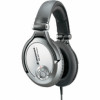Sennheiser PXC 450 Instructions for use - Page 12
Compared to the other buttons of the controller - noise
 |
View all Sennheiser PXC 450 manuals
Add to My Manuals
Save this manual to your list of manuals |
Page 12 highlights
º ´ Switching NoiseGard on and off The following prerequisites must be fulfilled for active noise compensation, NoiseGard 2.0: y a battery or rechargeable battery is inserted and y the normal/bypass · sliding switch is in the "normal" position (see page 10). To switch on NoiseGard 2.0: ̈ Press the ON/OFF button ´ approx. 1 second. The LED º shines red. To switch off NoiseGard 2.0: ̈ Press the ON/OFF button ´ approx. 1 second. The LED º goes out. If NoiseGard is switched off, you can use the PXC 450 like typical headphones to listen to music. Note: - Compared to the other buttons of the controller, the ON/OFF button ´ is set somewhat lower to avoid accidental switching off. - If the batteries of the device are empty, the NoiseGard automatically switches off. However, the audio signal continues to be transmitted if you slide the normal/bypass sliding switch · into "bypass" position (see page 10). 11















